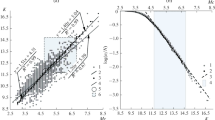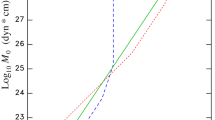Abstract
The earthquake magnitude was introduced into seismology nearly 40 yr ago, as a purely empirical concept. After an unparalleled success in scientific and practical applications the magnitude is developing into a concept with a clearer physical meaning and a more solid theoretical foundation.
The magnitude determined from the maximum particle amplitude or velocity reflects the maximum radiation power of the seismic source in the frequency band recorded on a particular seismograph. Recently developed models for seismic sources assist in classifying earthquakes according to size and spectral character. From corresponding scaling laws the relations between various magnitude scales can be established.
The magnitude aims at enabling one to compare the sizes of seismic sources ranging in character from nearly aseismic events to explosions. While the former are characterized by a relatively long-peroidic radiation maximum, the latter radiate primarily short-periodic seismic energy. Tectonic earthquakes are likely to range in character between the two extreme spectral cases. A comparison of earthquake magnitude with stellar magnitude leads to analogies in spectral character between earthquakes and stars, whereby seismic sources seem to follow a distribution similar to the Hertzsprung-Russell diagram for stars. Before seismological practice can catch up with the new cognitions, improvements in the definition of the earthquake magnitude are in need.
Similar content being viewed by others
References
Aki, K.: 1967,J. Geophys. Res. 72, 1217.
Aki, K.: 1972,Geophys. J. Roy. Astron. Soc. 31, 3.
Basham, P. W.: 1971,Geophys. J. Roy. Astron. Soc. 23, 255.
Båth, M.: 1969,Handbook on Magnitude Determinations. Seismological Institute, Uppsala, Sweden.
Båth, M.: 1973,Introduction to Seismology, Birkhäuser Verlag, Basel and Stuttgart, F.R.G.
Berckhemer, H. and Jacob, K.H.: 1968,Dynamical Processes in Earthquake Foci by Analyzing the Pulse Shape of Body Waves, Institute of Meteorology and Geophysics, University of Frankfurt F.R.G.
Brune, J. N.: 1968,J. Geophys. Res. 73, 777.
Brune, J. N.: 1970,J. Geophys. Res. 75, 4997.
Brune, J. N., Espinosa, A. and Oliver, J. E.: 1963,J. Geophys. Res. 68, 3501.
Brune, J. N. and Allen, C. R.: 1967,Bull. Seism. Soc. Am. 57, 501.
Byerly, P.: 1969,Bull. Seism. Soc. Am. 59, 1735.
Duda, S. J.: 1971,Pure and Appl. Geophys. 85, 71.
Eiby, G. A.: 1966,New Zealand J. Geol. and Geoph. 9, 122.
Evernden, J. F.: 1967,Bull. Seism. Soc. Am. 57, 591.
Evernden, J. F., Hibbard, R. R. and Schneider, J. F.: 1973,Bull. Seism. Soc. Am. 63, 399.
Galitzin, B. B.: 1912,Lectures on Seismometry, (in Russian),Publ. Imperial Academy of Sciences, St. Petersburg, Russia.
Ganse, R. A.: 1974,A Study of Earthquake Magnitudes and Their Relation to the Law of Seismic Spectrum Scaling, Saint Louis University. St. Louis, Mo., U.S.A.
Gutenberg, B.: 1945a,Bull. Seism. Soc. Am. 35, 57.
Gutenberg, B.: 1945b,Bull. Seism. Soc. Am. 35, 117.
Gutenberg, B.: 1958,Bull. Seism. Soc. Am. 48, 269.
Gutenberg, B. and Richter, C. F.: 1936,Gerl. Beitr. Geophys. 47, 73.
Gutenberg, B. and Richter, C. F.: 1956,Ann. Geofis. 9, 1.
Haskell, N. A.: 1960,J. Geophys. Res. 65, 4147.
Haskell, N. A.: 1962,J. Geophys. Res. 67, 4751.
Herrin, E., Arnold, E. P., Bolt, B. A., Clawson, G. E., Engdahl, E. R., Freedman, H. W., Gordon, D. W., Hales, A. L., Lobdell, J. L., Nuttli, O. W., Romney, G., Taggart, J., and Tucker, W.: 1968,Bull. Seism. Soc. Am. 58, 1196.
Jeffreys, H. and Bullen, K. E.: 1948,Seismological Tables, British Association for the Advancement of Science, London, England.
Kárník, V. Kondorskaya, N. V., Riznichenko, Ju. V., Savarensky, E. F., Soloviev, S. L., Shebalin, N. V., Vaněk, J., and Zátopek, A.: 1962,Studia Geophys. et Geodaet. 6, 41.
Nuttli, O. W.: 1972a,Bull. Seism. Soc. Am. 62, 343.
Nuttli, O. W.: 1972b,Proc. Intern. Conf. Microzonation, Seattle, Wash. 1, 307.
Nuttli, O. W.: 1973,J. Geophys. Res. 78, 876.
Richter, C. F.: 1935,Bull. Seism. Soc. Am. 25, 1.
Richter, C. F.: 1958,Elementary Seismology, W. H. Freeman Co., San Fransco, Calif., U.S.A.
Richter, C. F.: 1967, ‘Notes on Magnitude’, in M. Båth (ed.),Handbook on Magnitude Determination, (1969), Seismological Institute Uppsala, Sweden.
Rikitake, T.: 1972,Geophys. Surveys 1, 4.
Tsai, Y. B. and Aki, K.: 1970,J. Geophys. Res. 75, 5729.
White, R. E.: 1968,Bull. Seism. Soc. Am. 58, 1041.
Author information
Authors and Affiliations
Rights and permissions
About this article
Cite this article
Duda, S.J., Nuttli, O.W. Earthquake magnitude scales. Geophysical Surveys 1, 429–458 (1974). https://doi.org/10.1007/BF01452248
Issue Date:
DOI: https://doi.org/10.1007/BF01452248




